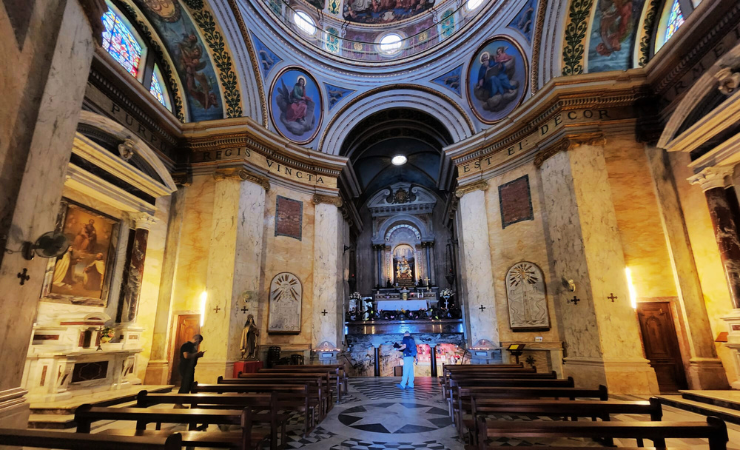Stella Maris: The Heart of the Carmelite Denomination
Originally published: October 2023 | Last updated: June 2025
The Stella Maris Church and Monastery is home to the Discalced Carmelite monks. It beckons visitors with its rich history and spiritual significance.

Location
Situated in the vibrant city of Haifa, the Stella Maris Church graces the slopes of Mount Carmel. With the Mediterranean Sea to its west and the bustling city to its east, it offers a serene spiritual retreat amidst urban surroundings.
Historical context
The Carmelite Beginnings
The roots of the Stella Maris Church and Monastery trace back to the 12th century during the Kingdom of Jerusalem’s reign. Religious hermits, inspired by the Prophet Elijah, began to inhabit the caves of Mount Carmel. By the early 13th century, these hermits sought a written rule of life from the Latin Patriarch of Jerusalem, Albert Avogadro. This marked the birth of the Carmelite Order, known as the ‘Order of the Brothers of Our Lady of Mount Carmel’.
However, the fall of Acre in 1291 to the Mamluks forced these monastic hermits to leave the Holy Land. The Carmelite order then spread across Europe, with King Saint Louis taking six Carmelites back to France in 1254.
But in 1631, the Discalced branch of the Order returned to the Holy Land, establishing a small monastery near a lighthouse on Mount Carmel only to be vacated in 1761 by Zahir al-Umar, leading to the monastery’s demolition.
The current location of the monastery is believed to be directly above a grotto where the prophet Elijah resided. Here, the Carmelites built a large church and monastery, which unfortunately faced destruction during Napoleon’s 1799 campaign. The church was later completely destroyed in 1821 by Abdullah Pasha of Acre. The present church and monastery were inaugurated in 1836 and were later recognized as a Minor Basilica by Pope Gregory XVI.



The Origin of the Name Stella Maris
During the rein of the Kingdom of Jerusalem’s in the 12th century CE, religious hermits, inspired by the Prophet Elijah, began to inhabit the caves of Mount Carmel. By the early 13th century, these hermits sought a written rule of life from the Latin Patriarch of Jerusalem, Albert Avogadro. This marked the birth of the Carmelite Order, known as the ‘Order of the Brothers of Our Lady of Mount Carmel’. The name “Stella Maris”, translating to “Star of the Sea”, was dedicated to the Virgin Mary.
The name “Stella Maris” is Latin for “Star of the Sea.” Traditionally, this title has been associated with the Virgin Mary. In Christian symbolism, the “Star of the Sea” represents guidance and hope, much like how sailors have historically used stars for navigation. The Virgin Mary, under this title, is seen as a guiding star leading the faithful, especially in times of distress, towards Jesus. The name signifies the role of the Virgin Mary as a beacon of hope, guidance, and protection for believers. In the context of the Stella Maris Church in Haifa, it emphasizes the church’s dedication to the Virgin Mary and its spiritual significance as a place of refuge and guidance.

A Dive Into the Stella Maris Church Architecture and Surroundings
Interior Design
The Stella Maris Church is a marvel of interior design. Its walls are adorned with white marble panels, meticulously arranged to give an illusion of painted walls. The brightness and placement of these panels captivate visitors, offering a serene ambiance.
Layout: The church is built in the shape of a cross, a design rich in spiritual symbolism.
The Dome: Painted between 1924 and 1928 by Luigi Poggi, a lay brother, the scenes stretch across both Testaments—Elijah rising to heaven in a fiery chariot, King David with his harp, prophets like Daniel, Ezekiel, and Isaiah, the Holy Family, and the founding figures of the Carmelite order. Latin verses from the Bible circle the dome like a sacred halo.
The Altar: Set on the eastern end, the raised altar is the visual and spiritual focal point. Above it stands a statue of Mary holding the infant Jesus—known as “Our Lady of Mount Carmel.” In her right hand she holds the Scapular, a symbol of Carmelite devotion. Two verses surround the altar space: “Thine head upon thee is like Carmel” (Song of Solomon 7:5) and “The Excellency of Carmel and Sharon, they shall see the glory of the LORD” (Isaiah 35:2).
Elijah’s Cave: Beneath the altar is a small, sacred cave—about 3 by 5 meters—where tradition says Elijah the Prophet once stayed. A Latin inscription tells the story: “This cave was once the dwelling of the great leader and father of the prophets – Elijah the Tishbite.” Inside, behind marble columns, a stone altar sits at the center, with a statue of Elijah watching over. It’s believed that the stone is the very bedrock where Elijah rested. At the entrance, three commemorative markers honor the early Carmelite figures Berthold, St. Brocardus, and Prosper.
Art and Light: The north wall features a marble-framed panel flanked by reddish columns. In the artwork, St. Teresa and St. John of the Cross look toward St. Joseph holding baby Jesus—linking the monastery to the Discalced Carmelite reform of the 16th century. Nearby, a stained-glass window captures the dramatic moment from 2 Kings 2: Elijah taken up in a fiery chariot as Elisha watches and picks up his mantle. Around the central hall, newer reliefs celebrate other Carmelite saints and thinkers.
The Organ: On the western wall stands a grand organ, often played during services and concerts, filling the church with deep, resonant music.
Outside the Stella Maris Church
Facing the Sea: The monastery’s western side opens to stunning sea views.
Monuments Among the Palms: Nestled between the palm trees are two memorials with deep historical weight:
One is a small pyramid-shaped stone topped with an iron cross. It honors 200 French soldiers who were killed by the Ottomans in 1799. The Latin inscription quotes 2 Samuel 1:27: “How are the mighty fallen, and the weapons of war perished!” Their remains were collected in 1804 and finally laid to rest beneath the stone in 1827.
Nearby stands another iron cross, mounted on a small round base. It commemorates French sailors who died aboard the Chateau-Renaud during a naval attack on Acre.
Carmelite Seal: Just above the entrance to the church is the official Carmelite emblem. A crowned arm holds a sword—symbolizing Elijah’s prophetic zeal—with a quote from 1 Kings 19:10 etched in Latin: “…I have been very jealous for the LORD God of hosts.”
Welcome Message: Right at your feet as you approach the entrance, the words “Ave Maris Stella” (“Hail, Star of the Sea”) are laid into the floor—a traditional title for Mary that feels especially fitting here on the edge of the sea.
Additional Information
Ancient Times / Biblical Period:
- 10th-9th Century BCE (approx.): Prophet Elijah is active on Mount Carmel. He goes to the top of Carmel, casts himself down, and holds a contest with the false prophets (1 Kings 18:42). Carmelite tradition holds that Elijah stayed in a cave now located under the altar of the Stella Maris church. Later Jewish tradition also associates a cave in the area with Elijah’s follower, Elisha.
Roman/Byzantine Period:
- A Roman/Byzantine site exists at the area of Stella Maris, with some findings displayed at the monastery entrance. A chapel is believed to date back to the Byzantine Empire, and a medieval Greek church (Abbey of St. Margaret) also existed on the current site.
Crusader Period:
- Late 12th Century: Frenchman Berthold (died 1188), a Crusader, leads a group of hermits who go into seclusion in the caves on Mount Carmel, inspired by Prophet Elijah’s simple way of life. This marks the outset of the Carmelite Order, named after Mount Carmel.
- Between 1206 and 1214: The leader and prior (referred to as ‘Brother B,’ sometimes believed to be Saint Brocard or Saint Bertold) asks Albert Avogadro, the Latin Patriarch of Jerusalem, to provide a written rule of life for the hermits. This establishes the “Order of the Brothers of Our Lady of Mount Carmel” (Carmelites) and gives them official recognition.
- Around 1226: The Carmelite hermits build their first small church (St. Brocardus) dedicated to Our Lady, near their grottos in the e-Siah (now Nahal Siakh) brook on the western slopes of Mount Carmel.
- Around 1240: The first Carmelite convents are founded in Europe.
- 1254: King Louis IX of France, returning from a Crusade, brings six Carmelites back to France, promoting their expansion in Europe.
- 1291: With the Mamluk siege and conquest of Acre (the capital of the Crusader Kingdom of Jerusalem), the Arabs defeat the Crusaders. Carmelite monks are butchered, and their church is destroyed. Survivors emigrate to Europe and do not return to the Holy Land for over two and a half centuries.
Ottoman Period:
- Mid-17th Century: Carmelite hermits return to the Holy Land, residing in caves below Stella Maris.
- 1631: Father Prosper of the Holy Spirit (Prosper), a Spanish monk and head of the Discalced Carmelite community, arrives in the Holy Land and establishes a makeshift monastery on the promontory of Mount Carmel, near the lighthouse. This marks the return of the Discalced branch of the Order.
- 1761: Zahir al-Umar, the ruler of Galilee, orders the Carmelites to vacate their site and demolishes the monastery. The friars move to their present location, directly above a grotto where Elijah is said to have lived, clearing ruins of a medieval Greek church and a Byzantine chapel.
- 1799: During Napoleon Bonaparte’s campaign, the monastery serves as a hospital for sick and wounded French soldiers. After Napoleon retreats following his failed siege of Acre, 200 wounded French soldiers are left behind and butchered by the Ottomans. The monastery is demolished.
- 1804: The bones of the butchered French soldiers are collected.
- 1821: Abdullah Pasha of Acre orders the complete destruction of the ruined church to prevent its use as a fort. Its masonry is used to build his summer palace and a lighthouse.
- 1827: A cornerstone is laid for the re-establishment of the Stella Maris monastery. The collected bones of the French soldiers are buried in the garden under a memorial stone.
- 1836: The fort-like Stella Maris monastery, built under the orders and supervision of Brother Giovanni Battista Cassini, is completed and opened. Its ground floor has thick walls and small, barred openings for defense.
- 1839: Pope Gregory XVI bestows the title of Minor Basilica on the sanctuary, and it is known as “Stella Maris” (Star of the Sea).
- July 31, 1883: Laurence Oliphant publishes an article titled “St. Elias festivals and Carmelite Monastery,” describing his visit and the festivals held there on July 20 with 6,000 visitors. He notes the influential role of the monastery in the newly founded city of Haifa.
20th Century:
- 1924-1928: Luigi Poggi, a lay brother of the Church, decorates the ceiling of the church dome with scenes of Elijah, David, prophets, the Holy Family, and Carmelite founders.
- 1950s-1960s: Franciscan archaeologist Bellarmino Bagatti conducts excavations, bringing to light primitive grottos and remains of successive buildings, including a large chapel.
Nearby Sites
Mukhraka (Keren Carmel): This site is believed to be where Prophet Elijah confronted the prophets of Baal. It holds significant religious importance and offers panoramic views of the surrounding areas.
Bahá’í Gardens: These terraced gardens cascade down Haifa’s hillside, culminating in the golden-domed Shrine of the Báb. Itis a recognized as a UNESCO World Heritage Site.
Elijah’s Cave: This cave is where it is believed the Prophet Elijah hid after his confrontation with the prophets of Baal. It’s a pilgrimage site for Jews, Muslims, Druze, and Christians.
- German Colony: The German Colony is Haifa’s restored historic district. With its well-preserved buildings, vibrant restaurants, and cafes, it’s a delightful blend of history and modern-day culture.



